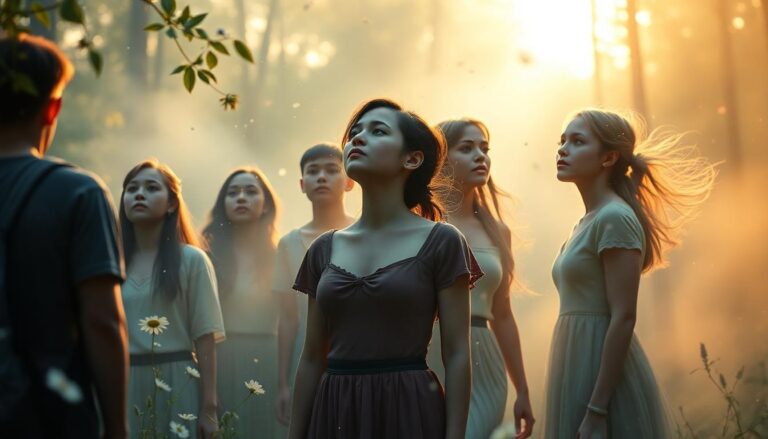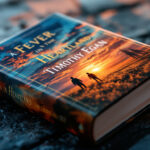Exploring Loss and Fantasy – A Review of The Book of Lost Things
John Connolly’s The Book of Lost Things offers a mesmerizing journey for readers young and old alike. At its heart is David, a twelve-year-old boy who faces the raw sting of loss when he loses his mother. As his life shifts, he’s drawn into a surreal world woven from the threads of dark fairytales. This isn’t your average tale of bedtime stories, but rather a deep dive into themes of grief, discovery, and transformation. It’s a tale where familiar narratives are spun on their heads, wrapping readers in a blend of the sinister and the magical. If you’re curious to see how these fantastical elements illustrate life’s more profound truths, you’re in for a real treat.
Plot Overview
The Book of Lost Things by John Connolly intertwines fantasy with reality, leading readers into a world that is both magical and unsettling. The story centers on a young boy, David, who grapples with personal loss and a journey that will transform him forever. This section will explore David’s transition into an alternate world and the overarching themes of grief and loss inherent in the narrative.
David’s Journey Through an Alternate World
David’s life changes dramatically after his mother falls ill and passes away. At just twelve, he’s faced with a whirlwind of emotions that he struggles to manage. Moving with his father and his new stepmother to a countryside estate only magnifies his feelings of isolation and resentment. Books become his refuge, and their whispers begin to blur the line between reality and fantasy. This review of The Book of Lost Things highlights how these narrative elements resonate with readers.
One fateful night, David hears a familiar voice—a whisper reminiscent of his mother’s. This voice lures him through a rift into a realm where stories he once adored have taken a sinister turn. It’s a landscape rife with danger, yet it is compellingly familiar. His journey in this world echoes classic tales, filled with twisted versions of beloved fairy tales, crafting a gripping narrative that challenges his courage and moral compass. His quest is not merely one of fantasy but a reflection of his inner turmoil and desire for closure.
Themes of Grief and Loss
Central to David’s journey is the profound exploration of grief and loss. As he navigates unfamiliar terrains, these emotions surface frequently, coloring his interactions and decisions. The narrative doesn’t shy away from depicting the messiness and complexity of these feelings. In fact, it serves as the very heart of David’s adventure, underpinning his aspirations and fears. The Aroma of Books blog offers further insights into how these themes are woven into the fabric of the story.
David’s transition to the alternate world becomes a symbolic journey through his personal pain. He encounters figures and situations that mirror his own struggles, forcing him to confront his emotions head-on. The characters he meets often act as catalysts, pushing him to redefine his understanding of love, loss, and resilience. The story suggests that grief is not a path to be avoided but a necessary journey that facilitates healing and growth. This allegorical tale thus serves as a mirror for anyone grappling with the labyrinth of human emotions, offering a reminder that transformation often comes from the darkest corners of our experiences.
Through this portal into a fantastical universe, Connolly masterfully illustrates that even in a world forged from dreams and nightmares, the realities of grief and loss leave an indelible mark, shaping who we are and who we wish to become.
Character Analysis
In John Connolly’s The Book of Lost Things, characters play pivotal roles not only in advancing the plot but also in illustrating profound themes of growth, loss, and transformation. Each character, from the protagonist David to the enigmatic Crooked Man, adds depth and richness to the narrative. Let’s explore these key players and their contributions to this fantastical story.
David: A Boy on the Brink of Adulthood
David, the protagonist, is a twelve-year-old grappling with the transition from childhood to adulthood, amplified by his mother’s death. Readers follow his journey as he navigates a perplexing world filled with dangers and moral tests. Initially, David’s character is defined by his grief and loneliness, which push him into a fantastical escape filled with twisted fairytales. Through the challenges he faces, he learns resilience and gains a deeper understanding of his emotions. His journey is not just physical but also a profound internal transformation. For a more detailed analysis, check this character development overview.
The Crooked Man: A Mysterious Antagonist
The Crooked Man embodies both menace and mystery in David’s journey. As a dark and wily figure, he serves as an antagonist that pushes David to confront his fears and vulnerabilities. While he is a villain, his role is more than just to instigate fear; he also acts as a catalyst for David’s personal growth. Understanding this character’s complexities can be compelling, as explored in this analysis of the Crooked Man. He weaves himself into the story intricately, challenging David to rise above his circumstances and urging him toward maturity.
Supporting Characters and Their Impact
Several supporting characters significantly impact David’s journey, each contributing to his development in unique ways. The Woodsman, for example, offers guidance and protection in David’s earliest moments within this alternate world, showcasing the importance of guardianship and wisdom. Similarly, the knight, with his principles and valor, serves as a symbol of moral integrity, inspiring David to confront his challenges with courage. For more insights into these secondary characters, take a look at this character study. These figures not only shape David’s experiences but enrich the narrative with varied perspectives on bravery, loyalty, and the complexities of human nature.
Fairytale and Mythical Influences
John Connolly’s The Book of Lost Things transports readers into a fantastical universe, deeply rooted in reimagined fairytales and mythological threads. This rich tapestry of storytelling transforms the novel into an evocative exploration of the human condition.
Twists on Classic Tales
Connolly’s genius lies in his ability to breathe new life into classic tales by layering them with dark, thought-provoking elements. Within the book, familiar stories are not merely borrowed but are reshaped to expose the shadows lurking within their narratives.
- Dark Spin on Beloved Characters: Characters that once seemed innocent now harbor sinister motivations. For example, in Connolly’s retelling, Little Red Riding Hood’s tale involves a chilling twist on innocence and predation (source).
- Morality Plays: These stories become platforms for exploring morality, as David, the protagonist, is thrust into scenarios that force him to grapple with integrity versus survival. Each tale serves as a metaphorical crossroad for David, challenging his inner moral compass (source).
These twists ensure that the reader confronts the darker aspects of humanity, often embedded within seemingly benign narratives, encouraging a reevaluation of the original tales.
Symbolism and Allegory
Beneath the surface of Connolly’s storytelling lies a world rich in symbolism and allegory, where fairytale elements often mirror real-world dilemmas. These deeper themes invite readers to reflect on personal and societal issues.
- Monsters as Inner Struggles: The grotesque creatures David encounters often symbolize internal fears or societal challenges. For instance, the vicious Loups represent the primal instincts that society attempts to repress, a reflection of the chaos that unchecked fear and anger can unleash (source).
- Journey as Growth: David’s journey through the fairytale world serves as a metaphor for maturation and self-awareness. Just as fairy tales often guide children through moral lessons, David’s travels symbolize his own path to understanding complex emotions like grief and acceptance (source).
Through these symbolic elements, Connolly crafts a narrative that not only entertains but also provokes introspection, offering insight into the resilience and vulnerability of the human spirit.
Writing Style and Tone
John Connolly’s The Book of Lost Things achieves a captivating atmosphere that pulls readers into its fantasy world while maintaining a pace that keeps them hooked. The writing style stands out, blending the whimsical with the mysterious, effectively blurring the lines between childhood wonder and adult realities.
Narrative Pacing and Structure
Connolly expertly balances the pacing in The Book of Lost Things, ensuring that readers remain engaged from start to finish. The novel’s structure resembles a classic hero’s journey, where David’s adventure unfolds in a way that feels both fluid and strategic. As the protagonist ventures deeper into the alternate world, each chapter successfully builds on the last, maintaining a rhythm that keeps the story moving without overwhelming the reader.
Connolly doesn’t rush through scenes; instead, he allows moments to breathe, giving characters room to reveal their complexities. This poised approach to storytelling ensures that the narrative doesn’t fall flat, but rather keeps readers questioning what will happen next (The Aroma of Books).
Atmospheric Descriptions and Imagery
The novel’s vivid descriptions create an irresistible immersion that draws readers into its fantastical yet foreboding world. Connolly uses rich imagery to paint scenes that resonate with readers, making them feel as though they are experiencing David’s journey alongside him. The lush descriptions help establish a setting that is both enchanting and menacing, reminiscent of dark fairytales (Review by Claire Huston).
Connolly’s use of atmospheric descriptions goes beyond mere decoration; it enriches the story by underlining the themes of loss and discovery. The intricate details of the landscape and characters serve a dual purpose: they immerse readers in the narrative while also reflecting David’s emotional battles. This level of descriptive writing makes Connolly’s work not just a story, but an experience that lingers long after the last page is turned.
Critical Reception and Impact
John Connolly’s The Book of Lost Things has stirred quite a mixture of critical reception and substantial impact since its release. This section focuses on what critics praise in the book, addressing its strengths, while also acknowledging the common criticisms that have emerged in discussions.
Praise from Critics
Critics have lauded The Book of Lost Things for its intricate character development and layered themes. Many readers find David, the young protagonist, particularly engaging as he navigates a world that mirrors his emotional struggles. This tale has been described as a captivating blend of fantasy and reality, charming audiences with its unique storytelling that transcends traditional genre boundaries.
Several experts have highlighted the book’s engaging narrative and its ability to weave deep philosophical questions into a fairytale setting. The narrative structure allows readers to connect with David’s journey on both a personal and fantastical level. This ability to intertwine dark fairy tale elements with personal growth themes makes the novel a standout in the fantasy genre.
Common Criticisms
While the book has received widespread praise, it is not without its critics. Some readers have pointed out issues with pacing, suggesting that certain parts of the narrative may feel slow or overly detailed. This critique often revolves around the extensive worldbuilding, which, although immersive, can sometimes detract from the story’s momentum.
Moreover, a few discussions have noted that the writing style, though richly descriptive, may occasionally feel heavy-handed to those who prefer a more streamlined narrative. However, for many fans, the book’s intricate prose is part of its appeal, creating a vivid and immersive world that resonates with the reader long after the final page.
In conclusion, The Book of Lost Things is a book that continues to leave a mark on readers and critics alike. Its strengths in character development and thematic depth are celebrated, while its narrative pacing and style receive mixed feedback, fostering vibrant discussions about its place in contemporary fantasy literature.
Conclusion
The Book of Lost Things by John Connolly weaves a mesmerizing tale combining the innocence of childhood with the stark realities of loss and courage. This reflection of a young boy’s journey through a twisted fairytale world strikes a chord with readers who find solace and understanding in its pages.
For anyone seeking a deep yet accessible dive into themes of grief and personal growth, this novel offers both comfort and challenge. The story encourages a re-examination of familiar tales, revealing the complexities hidden beneath their simple surfaces.
If this exploration of imagination and emotion intrigues you, why not dive into the book yourself? Share your thoughts and continue the conversation. Your reflections could uncover even more layers within this enchanting narrative.







